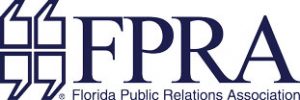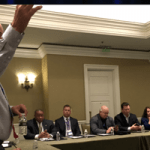Blogger: Laura Kern, APR, Orlando Area Chapter
Susan MacManus, Ph.D from the University of South Florida’s Department of Government and International Affairs presented at the Florida Public Relations Association’s Annual Conference about What Your Audiences Want and Expect.
In today’s political rhetoric, data is being covered by media and called into questions more than ever. As Director of the annual USF-Nielsen Sunshine State Survey, a statewide public policy-focused poll, and Florida’s most-quoted political scientist, Dr. MacManus shares her recommendations and what she sees for the future of polling.
There are a lot of expectations for data. It needs to be accurate, timely, easily digestible (for targeted audience), credible and defensible, on-point, useful for decision-making, and ethical.
The state of data is under scrutiny, since the majority of people are cynical about truthful reporting in the media, even though they choose which media to consume based on their ideology.
Fake news is now in Kenya.
#FakeNews has become a worldwide phenomenon. -Dr. Susan MacManus, @USouthFlorida #FPRAAC
— Katarina Dos Santos (@katarina_813) August 8, 2017
Any trust left in the media lies with local outlets. Dr. MacManus recommends focusing media pitches to these outlets to get an organization’s trusted news directly to your audience. News sources are hardly the reason for this mistrust, as factors that mostly impact people on their perceived trustworthiness in news sources include their gut instinct about the story and the person who shares the story with them.
You can learn from the bad 2016 election pollings and resulting reporting on them, by being clear about what you are trying to measure and what your data says.
Bottom line: a bad survey can be worse than no survey.
If you’re interested in polling your segment of the market here are some tips, directions and other great information from Dr. MacManus:
Polls are good for measuring:
- Attitudes
- Habits
Polls are bad for measuring:
- Demographics
- Public’s opinions on complex topics
- Recall (how much did you spend on coffee last week?) time bound are not useful
Types of polling firms:
- University/Academics
- Polls are typically run by students
- Florida’s language and culture variants make it difficult to have students conduct polls
- Think Tanks/Professional
- Firms: Brookings, Pew, Third Way (generational polling)
- Hire these firms for well designed polls with strong word choices for questions and question ordering
- Partisan
- Media
- Quick, short, timely, and cheap polls
- Advocacy/Adversarial Groups (Sponsors)
- Hybrids (Partnerships of Different Types of Firms)
Polls are not always the best source of information.
There are governmental organizations that have a lot of data, which may pertain to your questions. If you know the sources of data, you can save your client (and yourself) a lot of time and money.
Quick Tips for Creating a Good Poll:
- Do a little research up front. Has anyone else studied this area before? If so, does it answer your questions. If it didn’t, then still have it on hand to reference when you’re looking at your captured data.
- The words used in questions can result in different answers based on which and what order they are. Ask specific questions about what you want to know AND why.
- Narrow your target audiences to be as specific as possible.
What to look for (and include) in a methodology statement:
- How it was conducted
- Sample size
- Target population (adults, voters, etc.)
- Margin of error
- Random, probability, etc.
- Who conducted the poll
- If telephonic, are cell phones included
Good survey questions can include:
- A list to ask which are MOST helpful/desired/preferred/etc.
- Simple wording
- Simple explanations about acronyms, legislative issues, etc.
Do not include the following in your survey questions:
- Ask consumer to rank anything — you’ll miss valuable data and the data you receive from ranking questions are not usable.
- Bias infused in questions
Understanding respondent populations:
- Entire U.S. Population
- Americans of all ages
- Rarely surveyed; challenges in reaching children/teens (logistical, ethical, legal)
- U.S. Adult Population – “General Population”
- Americans ages 18 and older
- Most commonly used for public opinion and market research polls
- Registered Voters
- Either self-identified voter or sampled from list of registered voters
- Likely Voters
- Self-identified or identified from official voter rolls
Political polls have bias with more politically active people responding
- Downside: draws in more politically-active people
- Upside: for policy studies, representative despite low response rates
Focus Groups
Focus groups can give you very useful data. However, they tend to be expensive since you typically need to pay/incentivize people to participate.
This form of polling can help you develop survey questions, clarify research findings from another method, and observe nonverbal behavior, group dynamics, and emergent themes.
Structured with 7-12 participants, focus groups are conducted by a trained facilitator asking open-ended questions designed to promote discussion.
Presenting Your Findings
One of the most important parts of a study is presenting the results. Dr. MacManus recommends using graphics that follow these rules:
- Golden rule: Simple and self-contained
- Labeling of both axes is present and clear
- Adding numbers to graph can improve interpretation and recitation of the data
- Be attentive to intended audience
She also recommends using infographics as the best graphic option because:
- Humans process images faster than words
- 65% of population are visual learners
- More Americans now receiving their news from the internet
- Social media is playing a larger role in delivering news to the public
Essential elements of infographics:
- Data
- Should be clear and easy to understand
- Visualize when possible
- Color
- Every color should represent new layer of data (on graphs)
- Color used to set mood or theme
- Font
- Only use 2 or 3 fonts in one infographic
- Eliminate as much text as possible
- Should be clear to read (avoid scripts)
- Graphs
- Use direct labeling (avoid using a legend)
- Should be clean, concise, and clear
Future of Polling
The low response rate of polls is worrisome for the future of polling. Phone polls have a response rate of only 9 percent.
The following polling methods are being used increasingly:
- Telephone
- Live rather than IVR (robo-polls)
- Landlines and cellphones mix
- Online
- Probability-based panels
- Convenience samples
- Membership lists
- In-person
It’s important to know that “One Size Fits All” polls do not exist.
- Purpose of research differs (election forecasting vs. public policy/issue polling)
- Timeframe differs (intervening events impact results)
- Question pattern differs (repeat questions vs. new questions, cross-sectional vs. longitudinal data)
- Technique differs (online vs. telephone vs. cellphone vs. focus groups)
- Quality of pollster/polling firm differs
- Audience differs (professionals vs. general public)
Conclusion
Dr. MacManus’ best advice for your polling purposes is to stay current with trends and technology.
Key takeaways to keep in mind when considering polling:
- Demographic composition and trends
- Communication patterns of key audiences
- Polling techniques
- Reputable survey firms
- Graphics software
- Secondary sources
Organizations need public relations professionals to help convey key findings for organizations, to ensure the right information is communicated, in the correct fashion, at the optimal time, says Dr. MacManus.
Susan MacManus, Ph.D
Distinguished Professor



